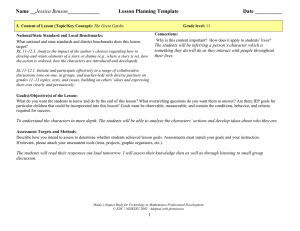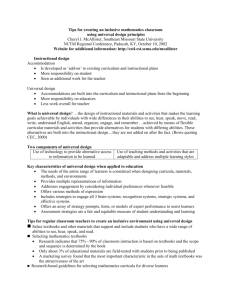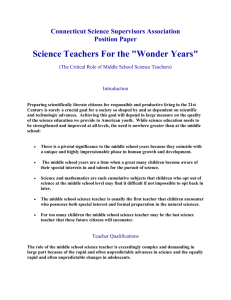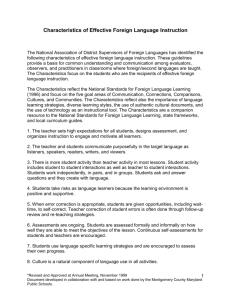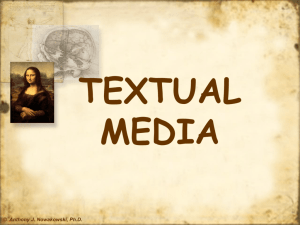Lesson Planning Template
advertisement
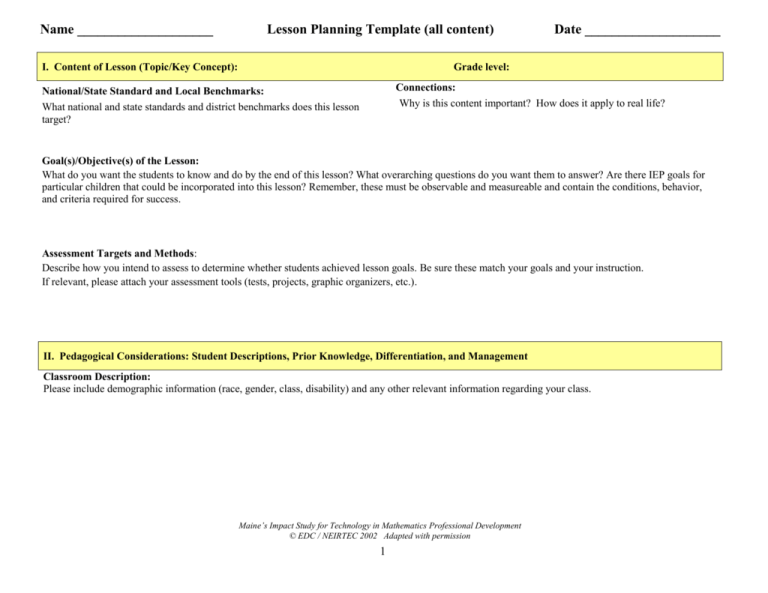
Name ____________________ Lesson Planning Template (all content) I. Content of Lesson (Topic/Key Concept): Date ____________________ Grade level: Connections: Why is this content important? How does it apply to real life? National/State Standard and Local Benchmarks: What national and state standards and district benchmarks does this lesson target? Goal(s)/Objective(s) of the Lesson: What do you want the students to know and do by the end of this lesson? What overarching questions do you want them to answer? Are there IEP goals for particular children that could be incorporated into this lesson? Remember, these must be observable and measureable and contain the conditions, behavior, and criteria required for success. Assessment Targets and Methods: Describe how you intend to assess to determine whether students achieved lesson goals. Be sure these match your goals and your instruction. If relevant, please attach your assessment tools (tests, projects, graphic organizers, etc.). II. Pedagogical Considerations: Student Descriptions, Prior Knowledge, Differentiation, and Management Classroom Description: Please include demographic information (race, gender, class, disability) and any other relevant information regarding your class. Maine’s Impact Study for Technology in Mathematics Professional Development © EDC / NEIRTEC 2002 Adapted with permission 1 II. Pedagogical Considerations: Student Descriptions, Prior Knowledge, Differentiation, and Management Student Descriptions: Select three students to keep in mind during this lesson designing process. These students should represent an academic, behavioral and/or social range of learners in your class (e.g. struggling, average, high performing). Specifically consider students who have a disability or are English language learners. Write a positive student profile for each of the students, at a minimum you must include the following information: 1) like/dislikes, 2) intelligences/strengths, 3) communication, 4) behavior, 5) academic performance, 6) subject specific performance, 7) social information, 8) concerns, & 9) other pertinent information. Prior Knowledge: What should students know to engage in the lesson? How will you determine the knowledge/skills your students have (formative assessment)? How will you build on this knowledge? What will you do if you find they do not have the anticipated prior knowledge? What are common misconceptions students may have regarding the content in this lesson that you will have to address? Classroom Management: What positive management strategies will you utilize during the lesson? How will you communicate your expectations of student behavior? What positive behavioral supports will be in place? Consider setting expectations, praising desired behavior, purposeful partnering/grouping, increasing student responsibility, individual behavior plan, choice, scheduled breaks, voice/tone, incentives, pacing, transitions (between and within lessons), etc. III. Technology Components/Considerations What instructional and/or assistive technology tools or resources you will use for this lesson? Keep in mind these can include high or low tech resources and may include such items as a tape recorder, radio, overhead projector, DVD/VCR, TV, computer, SMART Board, calculators, spell checkers, white boards, etc. Remember to include these within the instructional sequence. What are the limitations of the tool? How will you compensate for these limitations? Maine’s Impact Study for Technology in Mathematics Professional Development © EDC / NEIRTEC 2002 Adapted with permission 2 Preparation LESSON DESCRIPTION Materials Preparation: What type of preparation is needed before you can begin the lesson (seating arrangement, lab set-up, audio/video equipment, etc.)? What instructional resources/materials will you need? Questions for Learners (to guide instruction and check for understanding) Rationale Statements Identify and explain how the components of this lesson meet the specific needs of individual students (especially the three you described in the beginning of this plan) including receptive and expressive needs of students and ways to keep the students engaged. Introduction Lesson (steps of the lesson including transitions between steps) Remember to include instructional arrangement, lesson format, and other important organizational information for each step in your lesson. Also, include all of the directions you will give your students. Division of Responsibilities: What other adults will be present? Describe the roles and responsibilities of each. Maine’s Impact Study for Technology in Mathematics Professional Development © EDC / NEIRTEC 2002 Adapted with permission 3 Questions for Learners (to guide instruction and check for understanding) Rationale Statements Identify and explain how the components of this lesson meet the specific needs of individual students (especially the three you described in the beginning of this plan) including receptive and expressive needs of students and ways to keep the students engaged. Also Include Possible Lesson Adjustments: What will you do if you run short on time and are unable to finish the lesson or if your lesson took less time than expected and you have extra time? Closure Core Instruction Lesson (steps of the lesson including transitions between steps) Remember to include instructional arrangement, lesson format, and other important organizational information for each step in your lesson. Also, include all of the directions you will give your students. Please attach activity sheet(s) and assessment tools if used in the lesson. Also include a reference for where you found the idea. Maine’s Impact Study for Technology in Mathematics Professional Development © EDC / NEIRTEC 2002 Adapted with permission 4
